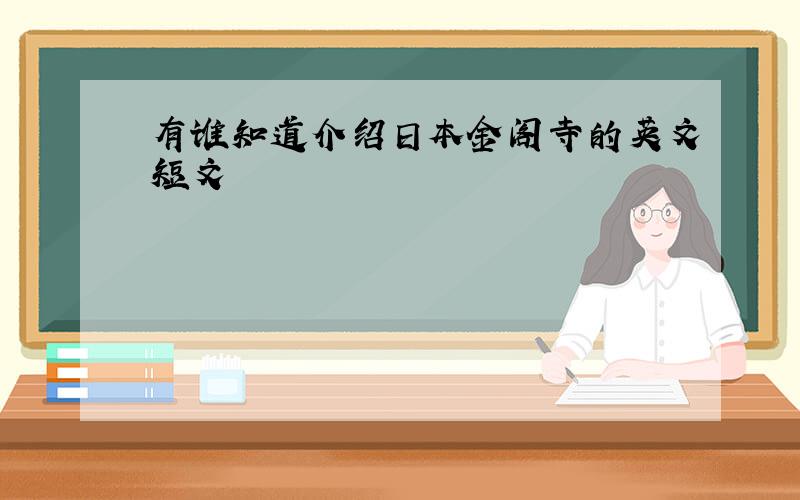有谁知道介绍日本金阁寺的英文短文
来源:学生作业帮 编辑:神马作文网作业帮 分类:英语作业 时间:2024/11/17 18:04:33
有谁知道介绍日本金阁寺的英文短文

金阁寺的官方简介.
Kinkaku-ji Guide
Its famous Golden Pavilion (Kinkaku)—actually a pagoda made to house the sacred relics of the Buddha—has given this temple the popular name of Kinkaku-ji ("Temple of the Golden Pavilion"),however the official name of this branch temple of the Rinzai-sect Zen temple of Shôkoku-ji is Rokuon-ji.The temple was designated as a UNESCO World Heritage Site in 1994.
During the Kamakura period (1185-1333),this land was the site of a villa of the aristocrat Saionji Kintsune,known as Kitayamadai.During the Muromachi period (1392-1573),however,it caught the attention of the third Ashikaga shogun Yoshimitsu (1358-1408),who took over the site from the Saionji family in order to build his own villa,which he called Kitayamadono.This complex,whose gardens and architecture focused around a central Golden Pavilion,was said to evoke paradise on earth and was the destination of such esteemed visitors as Emperor Gokomatsu (r.1392-1412),father of the Zen priest Ikkyû.The estate also became the center of the so-called "Kitayama culture," which was central in importing various aspects of Ming-dynasty Chinese culture into Japanese society,thanks to increased trade relations with Japan's continental neighbor.
After Yoshimitsu's death,the villa was turned into a temple according to his will,with Musô Sôseki (also known as Musô Kokushi,1275-1351) becoming its first abbot.The name Rokuon-ji was taken from the first two characters of Yoshimitsu's posthumous name.
The History of Kinkaku-ji
Kinkaku-ji's Location
Kinkaku-ji is located in Kinkakuji-chô,Kita-ku,in the northwester corner of Kyoto.It is a beautiful area,with the mountains Kinugasayama to the west and Hidari Daimonjiyama behind it.The range of mountains running along the northern part of Kyoto is known as Kitayama,but the area around Kinkaku-ji is sometimes referred to as Hokuzan,an alternative pronunciation of the characters used to write Kitayama.This name can be traced back to the Heian period (794-1185),and at that time was used to distinguish the larger area (Kitayama) extending north into Kyoto Prefecture from the smaller (Hokuzan) area close to Kinkaku-ji.From the mid-Heian period,many burial sites were located here,and there are still numerous tombs—among them that of Emperor En'yû (r.969-84)—crematories,graves,and burial mounds in the vicinity.Today the area to the west of Kinkaku-ji is known as Himuro ("ice chamber"),a name thought to derive from the ice chambers that the imperial court operated there.In winter,ice was cut into blocks and stored in chambers excavated in the deep recesses of Hidari Daimonjiyama and other mountains in the area,where it could be preserved for use in warm weather.In the past,the area was also regarded as a rich hunting grounds and a desirable locale for temples.The site of Kinkaku-ji,however,seems to have been primarily rice paddies and farmland,and was passed from its owner,the head of the Office of Shinto Worship,to Saionji Kintsune (1171-1244).Saionji built the first structures on the site,the Saion-ji family temple and a villa known as Kitayamadai.
Kinkaku-ji Guide
Its famous Golden Pavilion (Kinkaku)—actually a pagoda made to house the sacred relics of the Buddha—has given this temple the popular name of Kinkaku-ji ("Temple of the Golden Pavilion"),however the official name of this branch temple of the Rinzai-sect Zen temple of Shôkoku-ji is Rokuon-ji.The temple was designated as a UNESCO World Heritage Site in 1994.
During the Kamakura period (1185-1333),this land was the site of a villa of the aristocrat Saionji Kintsune,known as Kitayamadai.During the Muromachi period (1392-1573),however,it caught the attention of the third Ashikaga shogun Yoshimitsu (1358-1408),who took over the site from the Saionji family in order to build his own villa,which he called Kitayamadono.This complex,whose gardens and architecture focused around a central Golden Pavilion,was said to evoke paradise on earth and was the destination of such esteemed visitors as Emperor Gokomatsu (r.1392-1412),father of the Zen priest Ikkyû.The estate also became the center of the so-called "Kitayama culture," which was central in importing various aspects of Ming-dynasty Chinese culture into Japanese society,thanks to increased trade relations with Japan's continental neighbor.
After Yoshimitsu's death,the villa was turned into a temple according to his will,with Musô Sôseki (also known as Musô Kokushi,1275-1351) becoming its first abbot.The name Rokuon-ji was taken from the first two characters of Yoshimitsu's posthumous name.
The History of Kinkaku-ji
Kinkaku-ji's Location
Kinkaku-ji is located in Kinkakuji-chô,Kita-ku,in the northwester corner of Kyoto.It is a beautiful area,with the mountains Kinugasayama to the west and Hidari Daimonjiyama behind it.The range of mountains running along the northern part of Kyoto is known as Kitayama,but the area around Kinkaku-ji is sometimes referred to as Hokuzan,an alternative pronunciation of the characters used to write Kitayama.This name can be traced back to the Heian period (794-1185),and at that time was used to distinguish the larger area (Kitayama) extending north into Kyoto Prefecture from the smaller (Hokuzan) area close to Kinkaku-ji.From the mid-Heian period,many burial sites were located here,and there are still numerous tombs—among them that of Emperor En'yû (r.969-84)—crematories,graves,and burial mounds in the vicinity.Today the area to the west of Kinkaku-ji is known as Himuro ("ice chamber"),a name thought to derive from the ice chambers that the imperial court operated there.In winter,ice was cut into blocks and stored in chambers excavated in the deep recesses of Hidari Daimonjiyama and other mountains in the area,where it could be preserved for use in warm weather.In the past,the area was also regarded as a rich hunting grounds and a desirable locale for temples.The site of Kinkaku-ji,however,seems to have been primarily rice paddies and farmland,and was passed from its owner,the head of the Office of Shinto Worship,to Saionji Kintsune (1171-1244).Saionji built the first structures on the site,the Saion-ji family temple and a villa known as Kitayamadai.